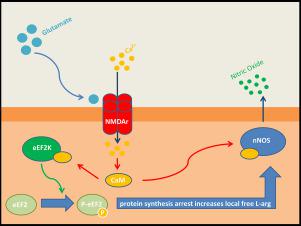Biochimica et Biophysica Acta (BBA) - Molecular Cell Research ( IF 4.6 ) Pub Date : 2020-06-20 , DOI: 10.1016/j.bbamcr.2020.118783 Luis Felipe Homem Gladulich 1 , Maria Carolina Peixoto-Rodrigues 1 , Paula Campello-Costa 2 , Roberto Paes-de-Carvalho 2 , Marcelo Cossenza 3

|
The NMDA receptor is crucial to several functions in CNS physiology and some of its effects are mediated by promoting nitric oxide production from L-arginine and activation of signaling pathways and the transcription factor CREB. Our previous work demonstrated in retinal cells that increasing intracellular free L-arginine levels directly correlates to nitric oxide (NO) generation and can be promoted by protein synthesis inhibition and increase of free L-arginine concentration. Eukaryotic elongation factor 2 kinase (eEF2K), a calcium/calmodulin-dependent kinase, is also known to be activated by NMDA receptors leading to protein synthesis inhibition. Here we explored how does eEF2K participate in NMDA-induced NO signaling. We found that when this enzyme is inhibited, NMDA loses its ability to promote NO synthesis. On the other hand, when NO synthesis is increased by protein synthesis inhibition with cycloheximide or addition of exogenous L-arginine, eEF2K has no participation, showcasing a specific link between this enzyme and NMDA-induced NO signaling. We have previously shown that inhibition of the canonical NO signaling pathway (guanylyl cyclase/cGMP/cGK) blocks CREB activation by glutamate in retinal cells. Interestingly, pharmacological inhibition of eEF2K fully prevents CREB activation by NMDA, once again demonstrating the importance of eEF2K in NMDA receptor signaling. In summary, we demonstrated here a new role for eEF2K, directly controlling NMDA-dependent nitrergic signaling and modulating L-arginine availability in neurons, which can potentially be a new target for the study of physiological and pathological processes involving NMDA receptors in the central nervous system.
中文翻译:

NMDA诱导中枢神经系统中一氧化氮的产生和CREB的激活取决于真核生物延伸因子2激酶。
NMDA受体对于CNS生理中的多种功能至关重要,其某些作用是通过促进L-精氨酸产生一氧化氮以及激活信号通路和转录因子CREB来介导的。我们以前的工作在视网膜细胞中证明,细胞内游离L-精氨酸水平的升高与一氧化氮(NO)的产生直接相关,并且可以通过蛋白质合成抑制和游离L-精氨酸浓度的增加来促进。还已知真核伸长因子2激酶(eEF2K),一种钙/钙调蛋白依赖性激酶,被NMDA受体激活,从而导致蛋白质合成抑制。在这里,我们探讨了eEF2K如何参与NMDA诱导的NO信号传导。我们发现当这种酶被抑制时,NMDA失去了促进NO合成的能力。另一方面,当通过环己酰亚胺或添加外源L-精氨酸的蛋白质合成抑制作用来增加NO合成时,eEF2K没有参与,表明该酶与NMDA诱导的NO信号传导之间存在特定联系。先前我们已经表明,对规范性NO信号通路(鸟苷酰环化酶/ cGMP / cGK)的抑制会阻止视网膜细胞中谷氨酸对CREB的激活。有趣的是,对eEF2K的药理抑制作用完全阻止了NMDA激活CREB,再次证明了eEF2K在NMDA受体信号传导中的重要性。总而言之,我们在这里证明了eEF2K的新作用,它可以直接控制NMDA依赖的硝化信号传导并调节神经元中L-精氨酸的利用率,











































 京公网安备 11010802027423号
京公网安备 11010802027423号